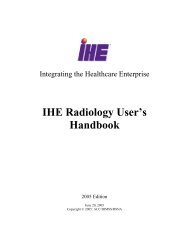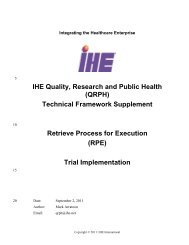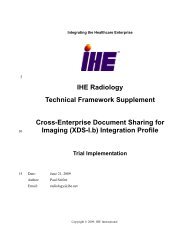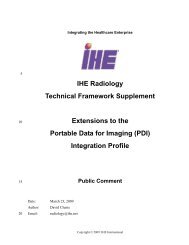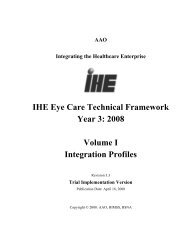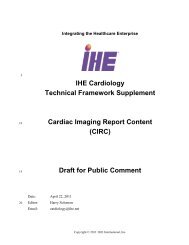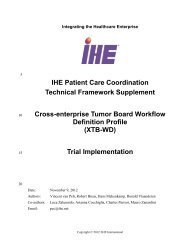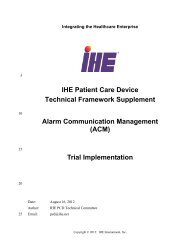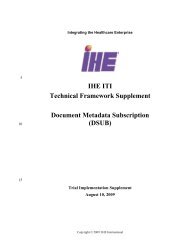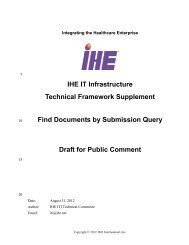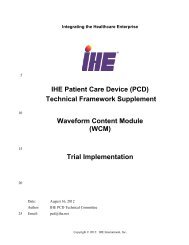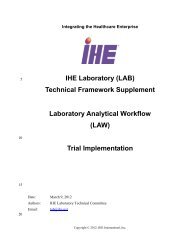IHE Patient Care Device Technical Framework
IHE Patient Care Device Technical Framework
IHE Patient Care Device Technical Framework
- No tags were found...
Create successful ePaper yourself
Turn your PDF publications into a flip-book with our unique Google optimized e-Paper software.
10<strong>IHE</strong> <strong>Patient</strong> <strong>Care</strong> <strong>Device</strong> <strong>Technical</strong> <strong>Framework</strong>, Vol. 2: Transactions________________________________________________________________________device specifies the prioritization within a given class (e.g., if a device has 10 highpriority alerts, and three are active, which is the highest priority of the three?). 7Additionally, an alert condition may be associated with the entire device (e.g., lowbattery), a particular channel (e.g., occlusion on infusion channel #2), or a specificparameter (e.g., heart rate too high). When communicated, the alert conditions should beassociated with the appropriate device scope or entity within the device’s informationcontainment tree or hierarchy. When associated with a given parameter (e.g., amonitored temperature or pressure reading), generic event codes are preferred over morespecific terms. For example, “low” or “high” or “irregular” as associated with amonitored heart rate parameter vs.” high beat rate” and “low beat rate”, etc. In mostcases, though, specific codes must be used, such as “gas contaminated” or “asystole”.Though some of these semantics are particular to a specific device, most are general andmay be applied to multiple devices. The following table provides examples of commonalert semantics that may be used in this TF 8 :<strong>Device</strong> Alert Event SemanticsDescriptionTerm CodeGeneral EventsAlarm MDC_EVT_ALARM (3::8)Disconnected MDC_EVT_DISCONN (3:22)Empty MDC_EVT_EMPTY (3::26)Error MDC_EVT_ERR (3::30)Failure MDC_EVT_FAIL (3::38)High MDC_EVT_HI (3::40)High – Greater than set limit MDC_EVT_HI_GT_LIM (3::42)INOP (device is inoperable) MDC_EVT_INOP (3::52)Low MDC_EVT_LO (3::62)Low – Less than set limit MDC_EVT_LO_LT_LIM (3::64)Occlusion MDC_EVT_OCCL (3::80)Range Error MDC_EVT_RANGE_ERR (3::164)Door / Handle Position Problem MDC_EVT_DOOR_OR_HANDLE_POSN_PROB (3::234)Fluid Line Problem MDC_EVT_FLUID_LINE_PROB (3::252)Gas is contaminated MDC_EVT_GAS_CONTAM (3::256)Lead is off / disconnected MDC_EVT_LEAD_OFF (3::272)Sensor problem MDC_EVT_SENSOR_PROB (3::312)Low signal level MDC_EVT_SIG_LO (3::380)Timeout MDC_EVT_TIMEOUT (3::584)Physiological/Medical EventsApnea MDC_EVT_APNEA (3::3072)7 Note: For <strong>IHE</strong> PCD TF Year 1, real-time alert communication and monitoring is out of scope.8 For a more complete listing of device alert semantics, see ISO/IEEE 11073-10101 section A.9Nomenclature, data dictionary, and codes for alerts (Block E), or Annex B.4 in the same standard.Rev. 1.1 TI: 2006-08-1572Copyright © 2005-2006: ACC, ACCE, HIMSS, and RSNA



